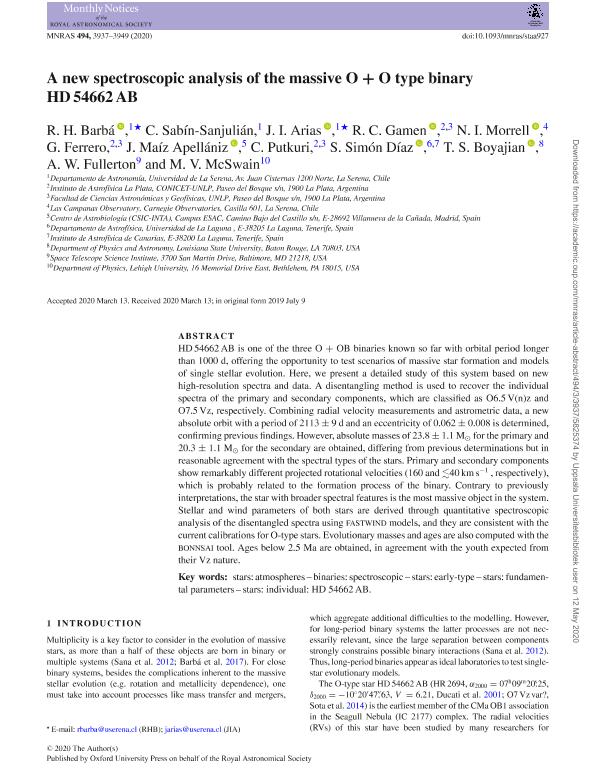Mostrar el registro sencillo del ítem
dc.contributor.author
Barba, Rodolfo Héctor

dc.contributor.author
Sabín Sanjulián, C
dc.contributor.author
Arias, J. I.
dc.contributor.author
Gamen, Roberto Claudio

dc.contributor.author
Morrell, Nidia Irene

dc.contributor.author
Ferrero, G
dc.contributor.author
Maíz Apellániz, Jesús

dc.contributor.author
Putkuri, C.
dc.contributor.author
Simón Díaz, S.
dc.contributor.author
Boyajian, T. S.
dc.contributor.author
Fullerton, A. W.
dc.contributor.author
McSwain, M. V.
dc.date.available
2021-09-01T16:12:25Z
dc.date.issued
2020-05
dc.identifier.citation
Barba, Rodolfo Héctor; Sabín Sanjulián, C; Arias, J. I.; Gamen, Roberto Claudio; Morrell, Nidia Irene; et al.; A new spectroscopic analysis of the massive O + O type binary HD 54662 AB; Wiley Blackwell Publishing, Inc; Monthly Notices of the Royal Astronomical Society; 494; 3; 5-2020; 3937-3949
dc.identifier.issn
0035-8711
dc.identifier.uri
http://hdl.handle.net/11336/139432
dc.description.abstract
HD 54662 AB is one of the three O + OB binaries known so far with orbital period longer than 1000 d, offering the opportunity to test scenarios of massive star formation and models of single stellar evolution. Here, we present a detailed study of this system based on new high-resolution spectra and data. A disentangling method is used to recover the individual spectra of the primary and secondary components, which are classified as O6.5 V(n)z and O7.5 Vz, respectively. Combining radial velocity measurements and astrometric data, a new absolute orbit with a period of 2113 ± 9 d and an eccentricity of 0.062 ± 0.008 is determined, confirming previous findings. However, absolute masses of 23.8 ± 1.1 M for the primary and 20.3 ± 1.1 M for the secondary are obtained, differing from previous determinations but in reasonable agreement with the spectral types of the stars. Primary and secondary components show remarkably different projected rotational velocities (160 and 40 km s−1 , respectively), which is probably related to the formation process of the binary. Contrary to previously interpretations, the star with broader spectral features is the most massive object in the system. Stellar and wind parameters of both stars are derived through quantitative spectroscopic analysis of the disentangled spectra using FASTWIND models, and they are consistent with the current calibrations for O-type stars. Evolutionary masses and ages are also computed with the BONNSAI tool. Ages below 2.5 Ma are obtained, in agreement with the youth expected from their Vz nature.
dc.format
application/pdf
dc.language.iso
eng
dc.publisher
Wiley Blackwell Publishing, Inc

dc.rights
info:eu-repo/semantics/openAccess
dc.rights.uri
https://creativecommons.org/licenses/by-nc-sa/2.5/ar/
dc.subject
stars: atmospheres
dc.subject
binaries: spectroscopic
dc.subject
stars: early-type
dc.subject
stars: fundamental parameters
dc.subject.classification
Astronomía

dc.subject.classification
Ciencias Físicas

dc.subject.classification
CIENCIAS NATURALES Y EXACTAS

dc.title
A new spectroscopic analysis of the massive O + O type binary HD 54662 AB
dc.type
info:eu-repo/semantics/article
dc.type
info:ar-repo/semantics/artículo
dc.type
info:eu-repo/semantics/publishedVersion
dc.date.updated
2021-08-17T15:54:20Z
dc.journal.volume
494
dc.journal.number
3
dc.journal.pagination
3937-3949
dc.journal.pais
Reino Unido

dc.description.fil
Fil: Barba, Rodolfo Héctor. Universidad de La Serena; Chile
dc.description.fil
Fil: Sabín Sanjulián, C. Universidad de La Serena; Chile
dc.description.fil
Fil: Arias, J. I.. Universidad de La Serena; Chile
dc.description.fil
Fil: Gamen, Roberto Claudio. Consejo Nacional de Investigaciones Científicas y Técnicas. Centro Científico Tecnológico Conicet - La Plata. Instituto de Astrofísica La Plata. Universidad Nacional de La Plata. Facultad de Ciencias Astronómicas y Geofísicas. Instituto de Astrofísica La Plata; Argentina
dc.description.fil
Fil: Morrell, Nidia Irene. Observatorio Las Campanas, Carnegie Institution; Chile
dc.description.fil
Fil: Ferrero, G. Consejo Nacional de Investigaciones Científicas y Técnicas. Centro Científico Tecnológico Conicet - La Plata. Instituto de Astrofísica La Plata. Universidad Nacional de La Plata. Facultad de Ciencias Astronómicas y Geofísicas. Instituto de Astrofísica La Plata; Argentina
dc.description.fil
Fil: Maíz Apellániz, Jesús. Csic-Inta. Centro de Astrobiología; España
dc.description.fil
Fil: Putkuri, C.. Consejo Nacional de Investigaciones Científicas y Técnicas. Centro Científico Tecnológico Conicet - La Plata. Instituto de Astrofísica La Plata. Universidad Nacional de La Plata. Facultad de Ciencias Astronómicas y Geofísicas. Instituto de Astrofísica La Plata; Argentina
dc.description.fil
Fil: Simón Díaz, S.. Instituto de Astrofísica de Canarias; España
dc.description.fil
Fil: Boyajian, T. S.. Louisiana State University; Estados Unidos
dc.description.fil
Fil: Fullerton, A. W.. Space Telescope Science Institute; Estados Unidos
dc.description.fil
Fil: McSwain, M. V.. Lehigh University; Estados Unidos
dc.journal.title
Monthly Notices of the Royal Astronomical Society

dc.relation.alternativeid
info:eu-repo/semantics/altIdentifier/url/https://academic.oup.com/mnras/article/494/3/3937/5825374
dc.relation.alternativeid
info:eu-repo/semantics/altIdentifier/doi/http://dx.doi.org/10.1093/mnras/staa927
Archivos asociados
